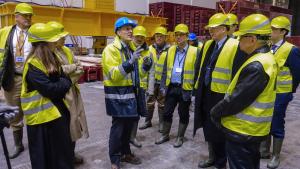Naturally, a critical aspect of the Committee's review was a visit to ITER to gain a first-hand look at the status of the project. Participation in the trip was strong—enough so that the Committee expanded its visit into a formal two-day meeting, and invited a number of EUROfusion officials as well to present the European fusion research program.
ITER's presentations to the Committee, and the discussions that ensued, were centred around the science, engineering, and management of the project.
As pointed out by Tim Luce, Head of the ITER Science & Operations Department, ITER by design will answer several long-standing fusion energy questions, such as: Does self-heating work? How large does a plasma need to be to achieve dominant self-heating? Is steady-state operation feasible in a burning plasma? Can helium ash be exhausted? Are plasmas disruption-free in stationary conditions?
ITER will also address a broad variety of plasma physics issues, ranging from the existence of "intrinsic" rotation to the mechanism of the
L-H transition or the origin of isotope scaling. To the group of scientists that comprise the Committee, this discussion made especially compelling arguments about the value of a machine built to ITER's specifications.
Deputy Director-General Gyung-Su Lee and Head of the Project Control Office, Hans-Henrich Altfeld, respectively presented the engineering and project management aspects of ITER. In both cases, the presentations and ensuing discussions took a detailed look at both the challenges evoked and why the Committee should have confidence in a successful outcome.
The worksite tour, as might be expected, was the highlight of the meeting. Nothing quite explains the scale and complexity of the project, nor inspires a knowledgeable scientist with the ITER mission, like an in-person tour of the Tokamak Complex.
In short, ITER made a strong case for the value of international collaboration in the fusion research enterprise—a case that was well-received by the Committee members. As Director-General Bigot declared in his closing remarks to the group, "the future of fusion—like the future of all big science—is partnership.


